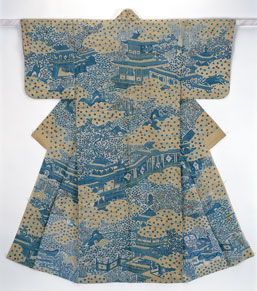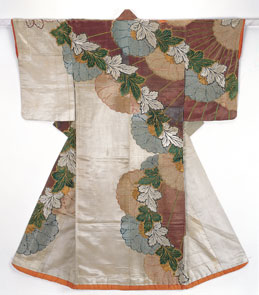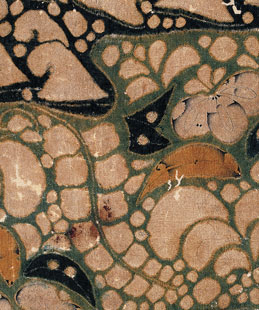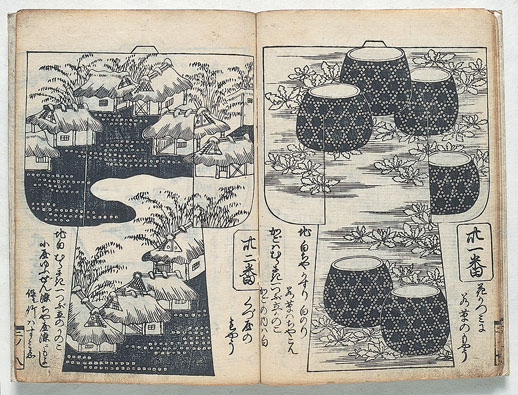The Narratives of Ornamented Textiles
Simply constructed, the kosode makes a bold statement. Based on straight lines and flat surfaces its design has survived the centuries and varies little from the present day kimono. Not that far removed from a painter’s canvas, the garments visual appeal perhaps lies in its potential to transform art into fashion.
This exhibition introduces over 300 Edo-period pieces from the Matsuzakaya Kimono Museum, established in 1931. Kosode (literally “narrow-cuffed dress”) form the focus of the collection, supplemented by other textiles such as Momoyama-period tsujigahana fabrics and Noh costumes, as well as numerous additional objects associated with costume.


The Edo period (1603-1868), characterised by its burgeoning merchant class, tremendous urban growth and wealth of artistic schools and styles, saw an increase in the consumption of luxury clothing. Textiles were the medium for the dissemination of style and subject in the decorative arts. They provided a means of utilizing new wealth in displays of taste, and even of refinement in the adaptation of literary themes in kosode design.

The scale of the exhibition allows you to see the changes in kosode style throughout the Edo period, however the arrangement of the pieces is not bound to a chronological order. Early period kosode appear to be predominantly simpler, tending to feature larger bolder motifs. Examples can be seen in two pieces, kosode with design of chrysanthemums in kanoko shibori dyeing and embroidery on white plain-weave silk and kosode with design of monochoria (mizuaoi) in kanoko shibori dyeing on red figured satin. Both boast bold simple designs, the beauty of which extends far beyond the surface pattern. The naming of the techniques themselves are evocative – “kanoko shibori” for example means ‘pattern of white spots’ referring to the white dappling on a fawn’s hide.

Other trends that can be picked out from the collection range from auspicious symbols, famous places (meisho), art objects and narrative. An obi depicting a design of pines, bamboo, plums in embroidery on white silk combines three auspicious plants, which would most likely be worn at an occasion such as New Year. Bamboo symbolising emptiness and thus symbolically the embodiment of the absence of self or ego is a recurring image. Along with pine, it also represents longevity. Plum blossom is an auspicious New Year flower and a harbinger of spring, as it is the first flower to bloom while snow is still on the ground. The reduction of the three plants to simple single motifs shows the extent to which they became significant visual icons.
An example of a narrative abstracted and reduced to its essentials for decorative purposes can be seen in the kosode with design of irises and plank bridges. The choice of flower and bridge alludes to part of episode nine, from the Tale of Ise, when the protagonist, Narihira, exiled from the capital pauses with his companions during their journey by a marsh filled with irises. There he composes a poem to express the sadness of finding himself so far from home. As the poem captures Narihira’s sensitivity to the beauty of nature, the wearing of such motifs would show the person’s appreciation of the literary classics and the informed viewer would understand the implicit reference to the original image. Literary themes were particularly celebrated by rinpa (literally Korin school) artists who sought to revive Heian period court classics such as The Tale of Genji and The Tale of Ise. As a single layer garment, colour and pattern are essential to the kosode such that the exhibition acts like a compendium of the diverse techniques, involving woven design, dyeing by various distinctive methods, embroidery, enrichment by metallic thread and painting in dyestuffs. Haute couture never looked more splendid.
Naomi Crowther
Naomi Crowther


